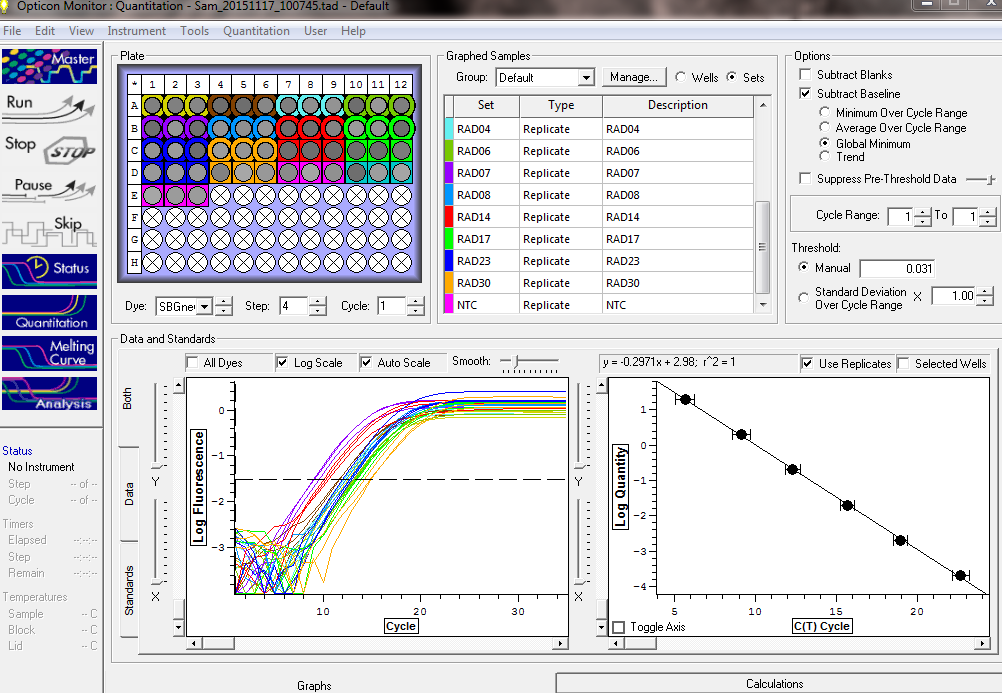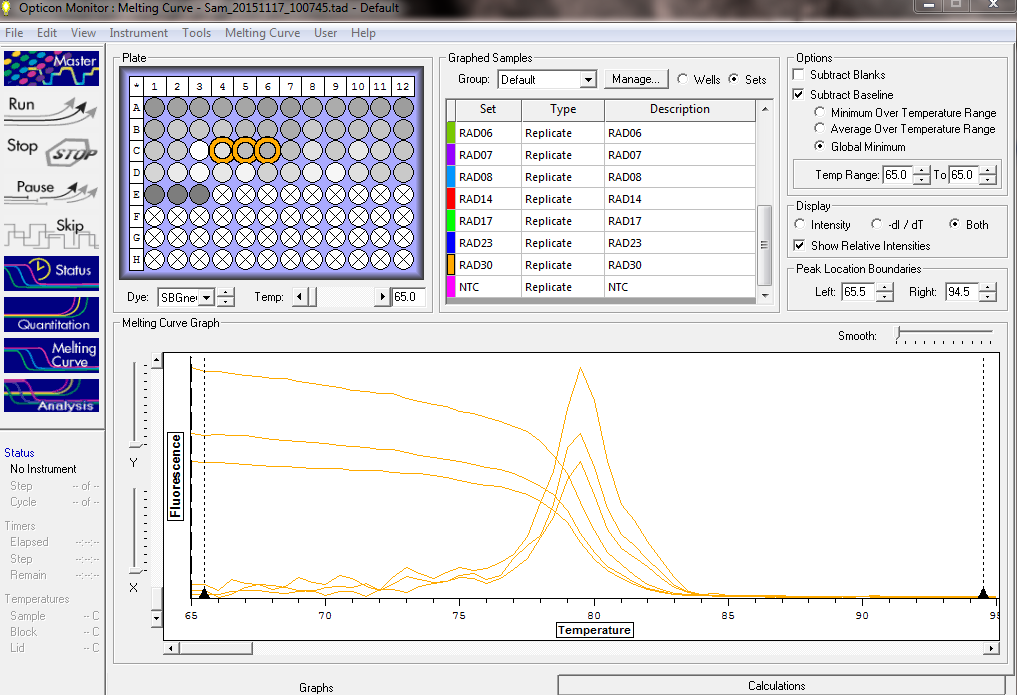After yesterday’s attempt at quantification revealed insufficient dilution of the libraries, I repeated the qPCRs using 1:100000 dilutions of each of the libraries. Used the KAPA Illumina Quantification Kit (KAPA Biosystems) according to the manufacturer’s protocol.
Made 1:100000 dilutions of each library were made with NanoPure H2O.
Ran all samples, including standards, in triplicate on the Roberts Lab Opticon2 (BioRad).
Plate set up and master mix can be found here: 20151117_qPCR_plate_layout_Oly_RAD.JPG
Results:
qPCR Data File (Opticon2): Sam_20151117_100745.tad
qPCR Data (Google Sheet): 20151117_RAD_qPCR_data
Overall, the new dilutions worked well, with all the library samples coming up between Ct 9 - 15, which is well within the range of the standard curve.
Manually adjusted the baseline threshold to be above any background fluorescence (see images below).
All samples, except Oly RAD 30, exhibit two peaks in the melt curve indicating contaminating primer dimers. Additionally, the peak heights appear to be roughly equivalent. Can we use this fact to effectively “halve” the concentration of our sample to make a rough estimate of library-only PCR products?
Here are the calculated library concentrations, based on the KAPA Biosystems formulas
| Library | Library Stock Conc. (nM) | Stock Halved (nM) |
| Oly RAD 02 | 46.70 | 23.35 |
| Oly RAD 03 | 79.35 | 39.67 |
| Oly RAD 04 | 61.35 | 30.67 |
| Oly RAD 06 | 30.61 | 15.30 |
| Oly RAD 07 | 477.05 | 238.53 |
| Oly RAD 08 | 46.32 | 23.16 |
| Oly RAD 14 | 224.91 | 112.46 |
| Oly RAD 17 | 24.56 | 12.28 |
| Oly RAD 23 | 49.56 | 24.78 |
| Oly RAD 30 | 11.19 | NA |
Amplification plots of standard curve samples:
 (http://eagle.fish.washington.edu/Arabidopsis/20151117_RAD_qPCR_stds_amp.png)
(http://eagle.fish.washington.edu/Arabidopsis/20151117_RAD_qPCR_stds_amp.png)
Melt curve plots of standard curve samples. Shows expected “shoulder” to the left of the primary peak:
 (http://eagle.fish.washington.edu/Arabidopsis/20151117_RAD_qPCR_stds_melt.png)
(http://eagle.fish.washington.edu/Arabidopsis/20151117_RAD_qPCR_stds_melt.png)
Amplification plots of RAD library samples:
 (http://eagle.fish.washington.edu/Arabidopsis/20151117_RAD_qPCR_samples_amp.png)
(http://eagle.fish.washington.edu/Arabidopsis/20151117_RAD_qPCR_samples_amp.png)
Melt curve plots of RAD library samples. Peak on the right corresponds to primer dimer. Peak heights between primer dimer and desired PCR product are nearly equivalent for each respective sample, suggesting that each product is contributing equally to the fluorescence generated in the reactions:
 (http://eagle.fish.washington.edu/Arabidopsis/20151117_RAD_qPCR_samples_melt_01.png)
(http://eagle.fish.washington.edu/Arabidopsis/20151117_RAD_qPCR_samples_melt_01.png)
Melt curve plot of Oly RAD library 30. Notice there’s only a single peak due to the lack of primer dimers in this sample:
 (http://eagle.fish.washington.edu/Arabidopsis/20151117_RAD_qPCR_samples_melt_02.png)
(http://eagle.fish.washington.edu/Arabidopsis/20151117_RAD_qPCR_samples_melt_02.png)